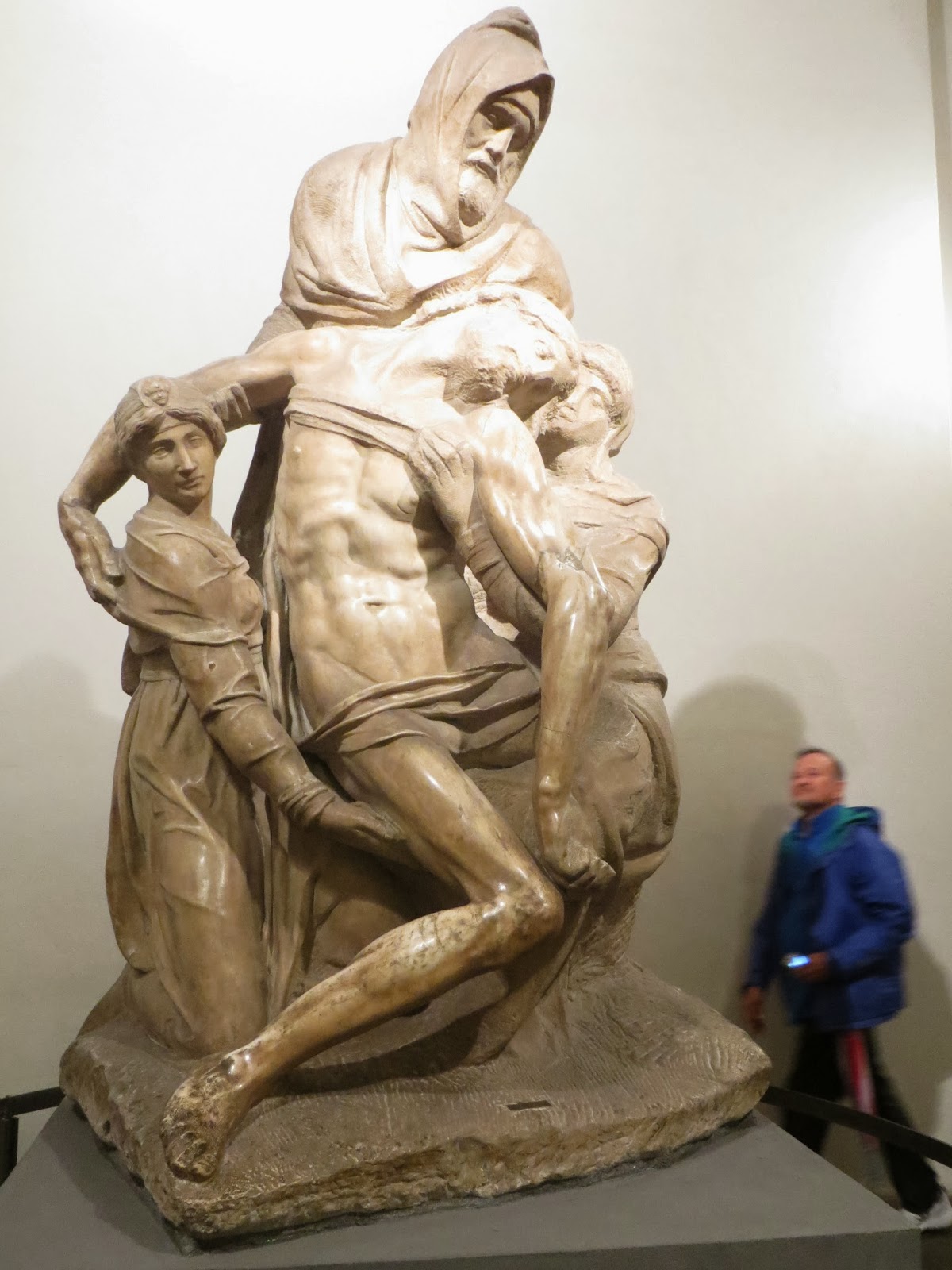Part
16: The Duomo
Florence’s Duomo (Cattedrale di Santa Maria dei Fiore) is famous
primarily because of its dome, designed by Filippo Brunelleschi. It is “the” landmark for Florence, the first
Renaissance dome and the model for domes to follow. The
church was more than 100 years in the making (1296-1436). In 1418 the Wool Merchants Guild (principal
patrons of the church) announced a competition for the design and building of a
dome that would cover the church.
Fillipo Brunelleschi, a local architect who had designed the Spedale
degli Innocenti, won. The dome would
have to be bigger than the dome of the Pantheon (diameter of 142 feet), but the
knowledge need to do that had been lost since the building of the Pantheon in
the first century AD. The city fathers forbade
using buttresses, and rafters long enough to span the 142 foot width were
impossible to come by.
Brunelleschi not only had to figure out how to build the dome, but
also invent the machines needed to do it:
such as a hoist for getting the bricks from the ground to the workers
170 feet above the floor .
Ross King has
written a fascinating history of how all this was accomplished in the book Brunelleschi’s
Dome.
The church and dome are huge – 370 feet tall. The nave of the church is the third longest
in Christendom. It was more than 400
years before a larger dome was built (Devonshire Royal Hospital, England,
1881). It remains the largest brick dome in the world.
Because it is located in a relatively small piazza, I found it hard
to get a good picture, both mentally and photographically.
The façade, which was not completed until the 1870s, is covered
with pink, green and white Tuscan marble, and looks to need a good cleaning. The
green marble appears black. There are
sections near the apse that look as they have been cleaned recently, and the
difference is a noticeable improvement. Numerous statues of saints and popes are
placed in niches around the front.
Across the piazza (about 100 feet) is the baptistery (battistero) with
its famous gilded bronze doors which Michelangelo dubbed the Gates of
Paradise. They were designed by Lorenzo
Ghiberti. The baptistery dates from the 11th century, and is one of
the city’s oldest buildings.
The "Gates of Paradise" today are copies of the
originals. In 1990 the originals were
moved into a dry environment in the Duomo’s museum, where they are being restored,
and some are on view.
These pictures are of the copies outside in the Piazza.
The interior
of the Duomo: The first
thing I noticed when we went inside the Duomo was its clean almost spare lines
– a real contrast from the exterior.
Much of the wall space is bare - many pieces that were once in the
church have been removed to the Duomo’s museum.
The marble floors are floral or geometric designs (unlike the
pictorials of Siena’s Duomo).
The interior of the dome, unlike the walls and floor, is a riot of
color and activity. It is a portrayal of
the Last Judgment.
There are 44 stained glass windows in the church – more than any
other church built to that time. The
ones in the cupola represent Christ and Mary.
Most of the ones on the lower walls represent saints.
The Duomo
Museum
The Museo dell'Opera del Duomo (Museum of the Works of the Cathedral)
holds many of the original works created for the Duomo. It is in the piazza to the right of the
Duomo.
Ghiberti’s Gates of Paradise are being restored there, and portions of them are on display.
These gilded bronze doors were executed by Lorenzo Ghiberti for the Baptistery in the first half of the 15th century. Ghiberti won a competition for the first set of doors in 1401, and was awarded another commission in1425 for a second second set. They were hung on the north and east entrances to the Baptistery. The first set were to serve as a votive offering to celebrate the sparing of Florence from relatively recent scourges such as the Black Death in 1348. It took Ghiberti 21 years to complete the first set, and 27 for he second. Together the panels depict the life of Christ from the New Testament, scenes from the Old Testament, and portraits of the four evangelists, John the Baptist and the Church Fathers Saint Ambrose, Saint Jerome, Saint Gregory and Saint Augustine.
Michelangelo referred to these doors as fit to be the "Gates of Paradise" and they are still invariably referred to by this name.
Also in the Museum is Michelangelo’s “The Deposition" a pieta which he intended for his own tomb. This is not “The Pieta” which is in St Peter’s in Rome.







































No comments:
Post a Comment